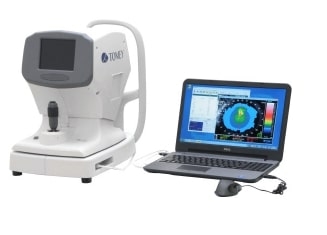High usability and reliability
Accessing the map analysis function is easy with just a few taps on the home screen. In addition to the keratoconus screening function and the Fourier Analysis function for measuring astigmatism, several reliable analysis tools provide accurate diagnostic information.
Automatic alignment with 3D eye tracking
Adjusting the alignment light in the first ring initiates automatic measurement, making the TMS-4N accurate even for less experienced examiners. Because the TMS-4N consistently produces clear images through automatic acquisition alignment, the risk of inaccurate color code maps is significantly reduced.
Several analysis tools
In addition to the Klyce/Maeda method, keratoconus assessment utilizes the Smolek/Klyce method of neural network classification. Keratoconus (even mild cases) is a contraindication to refractive surgery, and this assessment is useful for screening tests.
Using the Fourier analysis function, a normal color code map is decomposed into a spherical component of the cornea, a regular astigmatism component, an asymmetry component, and higher-order irregularities to assess the corneal shape in more detail. This function helps evaluate the irregular astigmatism component in corneal diseases and before and after refractive surgery.
The power difference map shows changes in corneal curvature. It is useful for assessing corneal shape changes after cataract surgery and for centration assessment after refractive surgery such as orthokeratology.
Axis Registration Method
It is possible to control the marking from the captured image, and the degree of marking can be measured. Using the obtained value, the fixation axis of the Toric IOL can be verified with greater accuracy.
14 Types of Corneal Shape Indices
TMS-4N establishes 14 types of corneal shape indices, such as the Corneal Eccentricity Index (CEI), which converts the flattening ratio of the cornea. Import data from our previous models; TMS-1, TMS-2, TMS-2N and TMS-4N for viewing maps and analyzing data.


